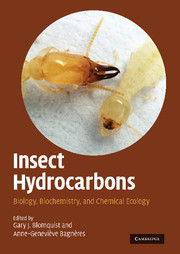Book contents
- Frontmatter
- Contents
- List of contributors
- Foreword
- Acknowledgments
- Part I Chemistry, Biochemistry, and Physiology
- 1 Introduction: history and overview of insect hydrocarbons
- 2 Structure and analysis of insect hydrocarbons
- 3 Biosynthesis of cuticular hydrocarbons
- 4 Molecular biology and genetics of hydrocarbon production
- 5 Site of synthesis, mechanism of transport and selective deposition of hydrocarbons
- 6 Cuticular lipids and water balance
- 7 Chemical taxonomy with hydrocarbons
- 8 Chemical synthesis of insect cuticular hydrocarbons
- 9 Oxygenated derivatives of hydrocarbons
- Part II Chemical Communication
- Index
8 - Chemical synthesis of insect cuticular hydrocarbons
from Part I - Chemistry, Biochemistry, and Physiology
Published online by Cambridge University Press: 18 May 2010
- Frontmatter
- Contents
- List of contributors
- Foreword
- Acknowledgments
- Part I Chemistry, Biochemistry, and Physiology
- 1 Introduction: history and overview of insect hydrocarbons
- 2 Structure and analysis of insect hydrocarbons
- 3 Biosynthesis of cuticular hydrocarbons
- 4 Molecular biology and genetics of hydrocarbon production
- 5 Site of synthesis, mechanism of transport and selective deposition of hydrocarbons
- 6 Cuticular lipids and water balance
- 7 Chemical taxonomy with hydrocarbons
- 8 Chemical synthesis of insect cuticular hydrocarbons
- 9 Oxygenated derivatives of hydrocarbons
- Part II Chemical Communication
- Index
Summary
The external cuticle of insects is covered by a waxy layer composed of mixtures of hydrophobic lipids that include long-chain alkanes, alkenes, wax esters, fatty acids, alcohols, aldehydes, and sterols. The primary purpose of this layer is to maintain water balance and prevent desiccation, as described in Chapter 6, but many of the cuticular lipid components have important secondary roles as intraspecific contact chemical signals (pheromones). These roles include species and sex recognition during reproductive interactions, and nestmate recognition and other colony organization functions in social insects. Thus, these compounds are essential mediators of insect behaviors. Cuticular compounds are also exploited by parasitoids and predators as interspecific contact cues (kairomones) to aid in host location.
Despite their critical importance in mediating insect behaviors, we still know very little about the detailed roles and mechanisms of insect cuticular lipids as signal molecules, in part because it is not immediately obvious how such signals could be manipulated and exploited for insect management, as is done with the more well-known volatile sex attractant pheromones. Even for the comparatively few species that have been examined in any detail, there are large gaps in our knowledge, for several reasons.
First, almost all studies of insect cuticular lipids have used gas chromatography (GC) to analyze lipid extracts, using standard GC conditions that only allow compounds under ∼C40 to be detected. More specialized GC equipment that can extend this range to >C60, in particular, columns that can withstand high temperatures (>400°C) are now available.
- Type
- Chapter
- Information
- Insect HydrocarbonsBiology, Biochemistry, and Chemical Ecology, pp. 163 - 186Publisher: Cambridge University PressPrint publication year: 2010
- 12
- Cited by



